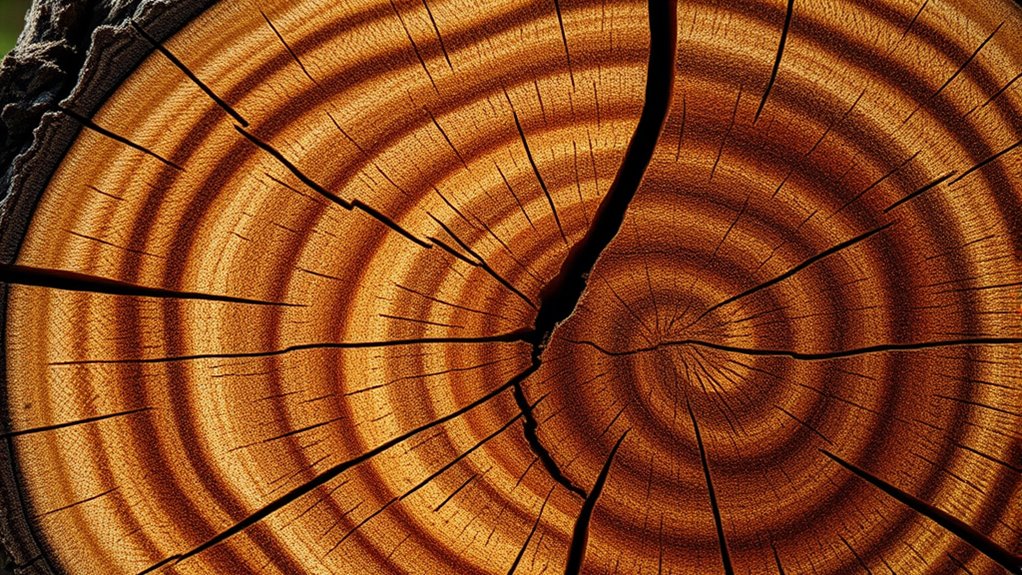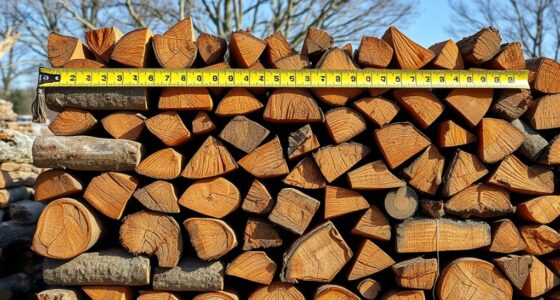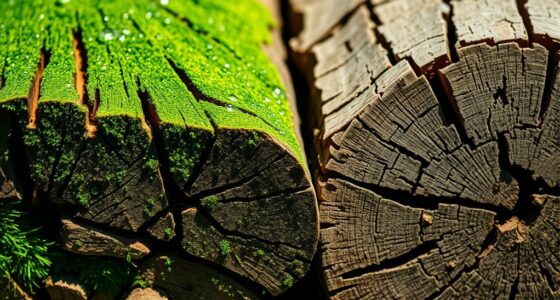The ideal moisture content for splitting firewood is between 15% and 20%. Logs within this range are light enough to split easily, not too wet to resist, nor too dry to shatter. If logs are wetter, they become harder to split and cause tool strain, while dryness below 15% makes them brittle and risky. To guarantee safety and efficiency, proper moisture management is key, and you can explore more ways to maintain ideal levels below.
Key Takeaways
- The ideal moisture content for splitting logs is between 15% and 20%.
- Moisture levels above 20% increase resistance and safety risks during splitting.
- Moisture below 15% causes brittleness, leading to shattering or unsafe splitting.
- Regular moisture measurement with a moisture meter ensures logs stay within the optimal range.
- Proper drying and storage practices help maintain logs at the ideal moisture level for safe, efficient splitting.
Understanding the Role of Moisture in Log Splitting
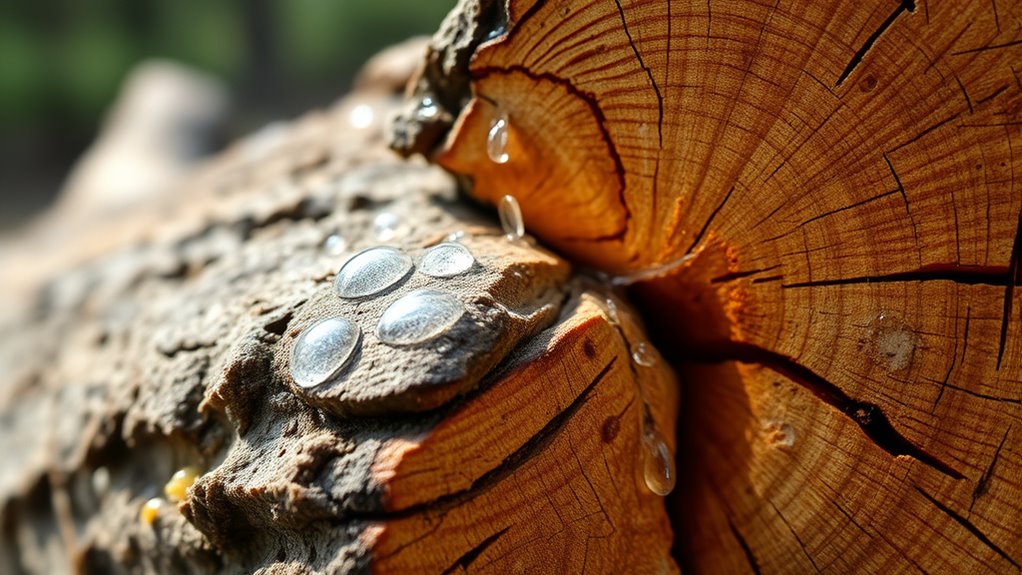
Moisture content in logs considerably affects how easily they split. When logs are too wet, they tend to be softer and resist splitting because the moisture acts as a glue holding the fibers together. You might notice wetter logs requiring more force or causing frustration because they resist splitting along natural grain lines. On the other hand, overly dry logs become brittle and may shatter instead of splitting cleanly. The moisture level influences the wood’s internal structure, making it either more pliable or more fragile, which highlights the importance of proper moisture management. Proper moisture balance ensures splits happen smoothly, saving time and effort while reducing the risk of damaging your tools. Maintaining an ideal moisture content ensures consistent splitting performance and minimizes wasted effort. Additionally, understanding wood grain can help predict how logs will respond to splitting under different moisture conditions. Being aware of the optimal moisture range can help you achieve the best results for efficient and clean splits.
The Ideal Moisture Range for Easy and Safe Splitting

Achieving the right moisture level is key to splitting logs efficiently and safely. For easiest handling, aim for logs with a moisture content between 15% and 20%. At this range, wood is dry enough to split with less effort, reducing strain on your tools and minimizing safety risks. If logs are too moist, usually above 20%, they tend to be heavy and resistant, increasing the chance of accidents or tool damage. On the other hand, logs that are too dry, below 15%, can be brittle and prone to shattering unexpectedly, which also poses safety concerns. Maintaining logs within this ideal moisture range guarantees they split cleanly and safely, making the process more manageable and less tiring. Proper moisture control ultimately leads to more efficient firewood preparation and safer splitting sessions. Additionally, using a moisture meter can help ensure your logs stay within the optimal moisture range for splitting. Understanding the cost of building a tiny house can also influence your decision to DIY or hire professionals, impacting your overall budget. Regularly checking the moisture content of your logs can prevent issues related to improper drying and improve your splitting experience. For precise moisture readings, employing digital moisture meters can provide more accurate results than traditional methods. Furthermore, being aware of cultural influences on wood quality can help in selecting better-suited logs for splitting.
How to Measure Moisture Content in Firewood

You can measure moisture content in firewood using a moisture meter or by inspecting visual indicators. Moisture meters provide quick, accurate readings, while visual clues like mold or bark looseness can help identify damp logs. Both methods are essential for ensuring your wood burns efficiently and safely. Additionally, knowing the ideal moisture level for splitting can improve your firewood preparation and burning performance. Properly dried wood with optimal moisture content also reduces smoke emissions and enhances overall combustion efficiency, aligning with best practices in AI in Business for operational optimization. Using the right crochet techniques can also aid in creating protective styles that minimize damage to the wood during processing. Ensuring the logs are split at the correct moisture content helps achieve more consistent drying and better combustion. Regularly checking moisture levels is crucial for maintaining optimal drying conditions, which directly impacts the quality of your firewood.
Moisture Meter Usage
Using a moisture meter is one of the most accurate ways to determine the moisture content in firewood. To get a reliable reading, follow these steps: 1. Insert the meter’s probes into the wood, ensuring they penetrate the core for an accurate measurement. 2. Choose the correct setting for wood type or moisture range, if available. 3. Press the button to activate the meter and wait a few seconds for the reading. 4. Read the digital display or dial, noting the moisture percentage. Additionally, ensuring proper filter maintenance of your air purifier can improve its efficiency and help maintain optimal indoor air quality. Regularly calibrating your moisture meter can also enhance measurement accuracy and is considered an important aspect of quality control in moisture measurement. Proper tuning of your equipment can further improve the precision of your readings and ensure consistent results.
Visual Moisture Indicators
While visual cues alone can’t provide an exact moisture percentage, they offer quick and practical ways to assess if firewood is adequately dried. Look for bark that’s loose or peeling, as this suggests the wood is dry. Check for cracks or splits along the logs; these form naturally as moisture escapes. Color can also be a clue—dull or faded wood often indicates dryness, while greenish or dark spots suggest moisture. Feel the wood’s weight; dry logs feel lighter than freshly cut ones. Additionally, listen for hollow sounds when you knock two pieces together, which signals dryness. While these indicators aren’t precise, combining them helps you determine if your firewood is ready for burning, ensuring efficient combustion and less smoke.
Effects of Overly Wet Logs on Splitting Efficiency
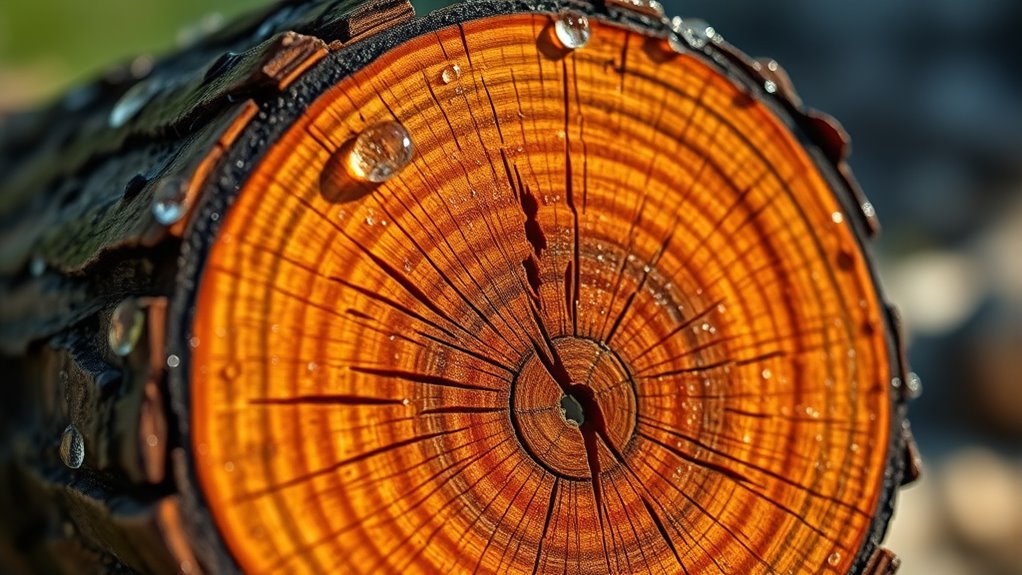
When logs are excessively wet, their splitting efficiency drops considerably because the moisture creates resistance and makes the wood harder to break apart. The increased moisture causes the fibers to stick together, making each strike less effective. You might notice:
- The axe bouncing off the log instead of sinking in.
- Increased force needed to split each piece.
- Splitting takes longer, tiring you out faster.
- The wood clinging to the axe, creating mess and frustration.
This resistance not only slows your work but also risks damaging your tools. Wet logs tend to be denser, requiring more effort and possibly breaking your axe handle if you push too hard. Proper moisture levels are essential for efficient, safe splitting.
Risks Associated With Dry and Brittle Logs
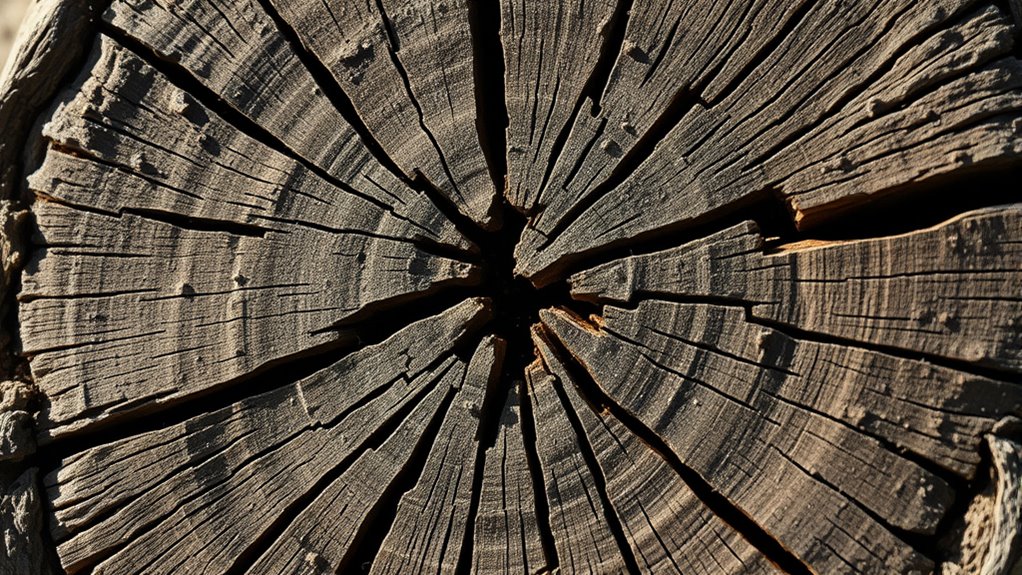
Although wet logs can hinder splitting by increasing resistance, overly dry and brittle logs pose their own set of dangers. When logs become too dry, they lose flexibility, making them prone to cracking unexpectedly. This brittleness increases the risk of the wood splintering or shattering during splitting, which can cause flying debris or accidental injuries. Such logs are more difficult to control and handle safely, especially if they break into unpredictable pieces. Moreover, dry logs are more likely to splinter along grain lines, complicating the splitting process. Handling brittle wood requires extra caution to prevent injuries. Overall, excessively dry logs compromise both safety and efficiency, highlighting the importance of maintaining an ideal moisture level for safer, more controlled splitting.
Techniques for Drying and Moistening Your Firewood
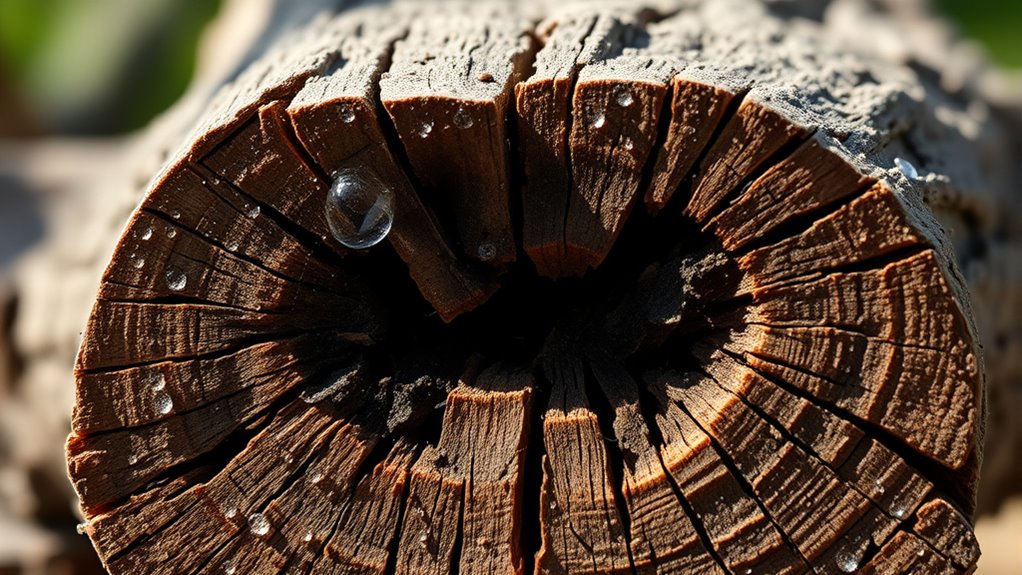
Properly drying and moistening firewood is essential for safe and efficient burning. To dry your logs effectively, you can:
- Stack logs off the ground in a well-ventilated area, allowing air to circulate freely around each piece.
- Cover the top of the pile with a tarp, but leave sides open for airflow.
- Split logs into smaller pieces to speed up moisture evaporation.
- Use a moisture meter regularly to monitor the logs, aiming for 20% moisture content.
To moisten logs, if they become too dry, you can spray them lightly with water and let them sit for a few hours. Proper techniques ensure your firewood burns cleanly and efficiently.
Seasonal Variations and Their Impact on Log Moisture
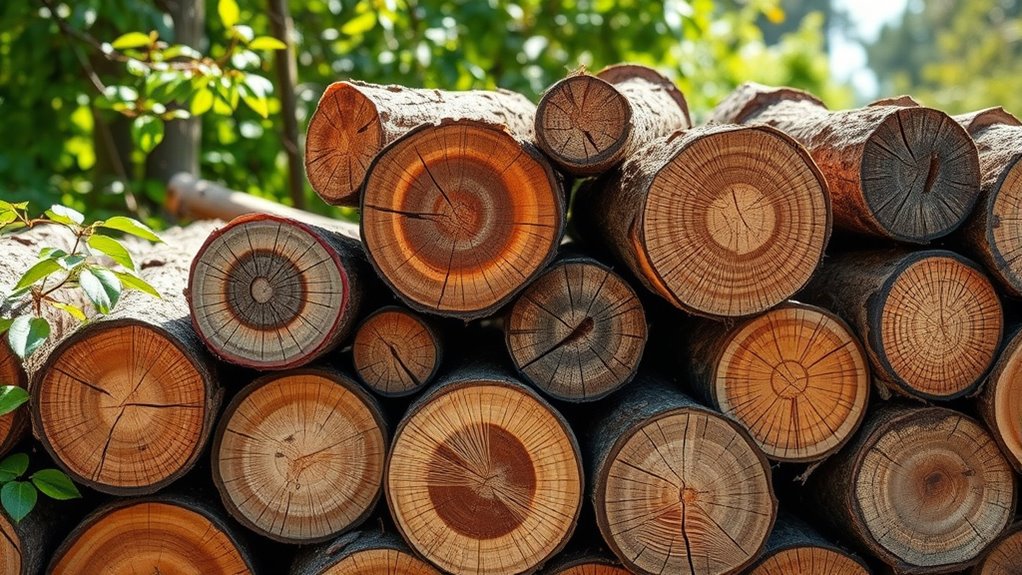
Seasonal changes markedly influence the moisture content of your firewood, affecting how well it burns and how efficiently it produces heat. During spring and summer, increased humidity and rainfall raise the moisture levels, making logs harder to ignite and less efficient. Conversely, in fall and winter, lower humidity and cooler temperatures help logs dry out naturally, reducing moisture content. You’ll notice that wood harvested in summer often requires longer drying times, while winter-cut logs tend to be drier already. These fluctuations mean you need to adapt your storage and handling practices seasonally. Properly accounting for seasonal variations ensures your logs stay closer to ideal moisture levels, leading to better burning performance and more effective heat output.
Tools and Methods to Achieve Optimal Moisture Levels
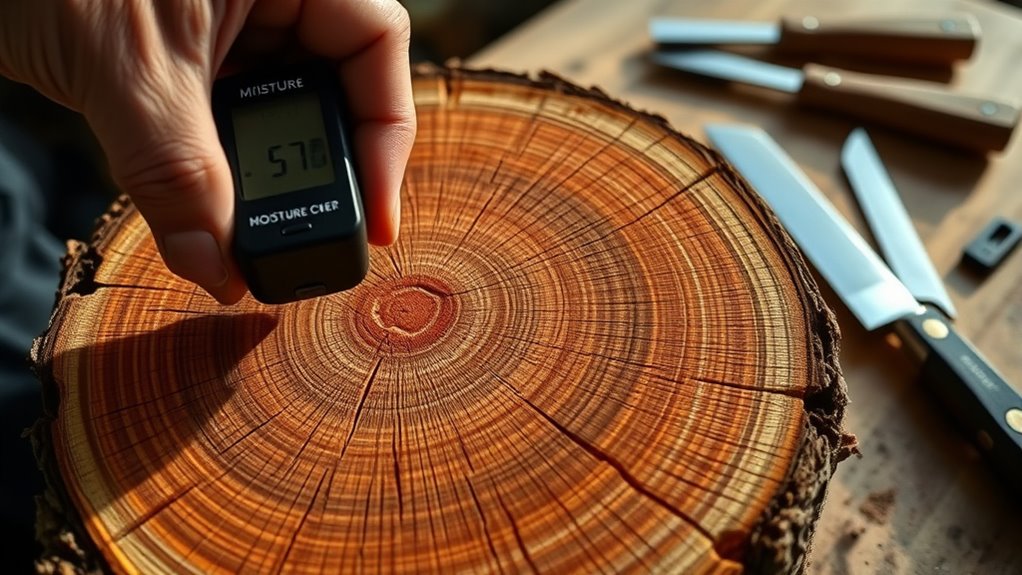
To guarantee your firewood reaches the ideal moisture level, using the right tools and methods is essential. First, you’ll need a moisture meter, which looks like a small, handheld device with metal prongs that you insert into the wood. Second, use a moisture scale or chart to compare your readings against perfect levels. Third, store logs in a well-ventilated space, like a shed or open shelter, to promote even drying. Fourth, turn the logs regularly, like flipping a pancake, to ensure consistent moisture loss from all sides. By combining these tools and techniques, you can accurately monitor and control moisture content, making your splitting process more efficient and your firewood more effective for burning.
Tips for Maintaining Proper Moisture Content During Storage

Once you’ve measured and adjusted the moisture content of your firewood, maintaining those levels during storage becomes the next important step. To do this, store your logs in a dry, well-ventilated area away from rain and humidity. Elevate the wood off the ground using pallets or pallets to prevent moisture absorption from the soil. Cover the top of your pile with a breathable tarp or wood cover, ensuring sides remain open for airflow. Avoid sealing logs completely, as proper air circulation helps keep moisture levels steady. Regularly check the moisture content with a meter to catch any changes early. Proper stacking and ventilation are key to preserving your firewood’s ideal moisture level, ensuring it burns efficiently when needed.
Frequently Asked Questions
How Does Moisture Content Affect the Longevity of Firewood?
Moisture content plays a vital role in how long your firewood lasts. When logs are too damp, they burn inefficiently, producing more smoke and creosote buildup that can damage your chimney. Dry wood, with proper moisture levels, burns cleaner and hotter, making your fire more efficient and reducing the risk of decay or mold over time. Keeping moisture in check helps your firewood stay good longer and perform better.
Can Atmospheric Humidity Influence Log Moisture Levels?
While a gentle whisper of the environment, atmospheric humidity can subtly influence your logs’ moisture levels. When humidity is high, logs tend to absorb moisture from the air, making them heavier and less ideal for burning. Conversely, dry air helps logs release excess moisture, aiding in proper seasoning. By understanding these atmospheric cues, you can better manage your firewood’s readiness, ensuring efficient and clean-burning fires.
What Are Cost-Effective Methods to Maintain Optimal Moisture?
To keep moisture levels balanced cost-effectively, you should store logs in a well-ventilated area to prevent excess humidity buildup. Cover logs with breathable material to shield them from rain while allowing airflow. Avoid over-drying by monitoring moisture regularly with a moisture meter. Additionally, stacking logs properly ensures good airflow, reducing moisture retention. These simple steps help you maintain ideal moisture for easier splitting and better burning efficiency.
How Quickly Can Moisture Levels Change in Stored Logs?
Moisture levels in stored logs can change quite quickly, especially under fluctuating weather conditions. If logs are exposed to rain or high humidity, they can absorb moisture within days. Conversely, if stored in a dry, well-ventilated space, they might dry out over a few weeks. You should regularly check your logs, especially during seasonal shifts, to guarantee they stay at the ideal moisture level for splitting and burning.
Are There Specific Wood Species More Sensitive to Moisture Variations?
Ah, the delicate dance of moisture in wood! You’ll find that softwoods like pine and spruce are more sensitive to moisture swings, shrinking or swelling noticeably. Hardwoods, such as oak and maple, resist changes a bit more, but they’re not immune. So, if you’re splitting logs, keep an eye on those softwoods—they’ll give you more trouble with moisture fluctuations, making your work a bit more challenging than it needs to be.
Conclusion
Maintaining the right moisture level makes splitting safer and easier. While some worry about extra drying time, investing in proper drying techniques pays off with smoother splits and less equipment strain. Don’t overlook seasonal changes—they affect moisture, but with simple tools and tips, you can keep your firewood at the perfect level. Keep an eye on moisture, and you’ll enjoy efficient, hassle-free splits all year round.
